For all those hooked on graphs and numbers, finding the proper business management software might be a struggle. Although there are many different tools made with small businesses in mind, they’re usually catered towards a specific group.
For photographers, there are Sprout Studio and Studio Ninja, while visual creatives can enjoy Bloom, just like consultants of all kinds can use Paperbell.
Unfortunately, accountants are a little bit neglected, so they won’t find features tailored to their craft. Instead, they’ll have to turn toward more universal tools.
SuiteDash is one of them. It’s an all-in-one Client Portal software that comes with robust automation options and various features that are necessary to cover all parts of your business, from CRM and LMS to marketing campaigns and team management.
Let’s see if SuiteDash has anything good to offer.
Client Management
Contacts, Companies & Circles
First of all, if you already have a big enough customer base, you can import all your contacts to the platform via a CSV import. It will require you to read carefully over the linked guide and follow the exact steps, but it still beats the manual work.
You can import your contacts either as individual Contacts or Companies. A Company is simply a group of contacts with one of them chosen as a Primary Contact, who will be getting all the notifications. Moreover, a Primary Contact is necessary to be able to assign any documents, like invoices or proposals, to contact a company through them, and to access a Client Portal.
Once imported, you can also create Circles, which is simply a group of contacts. This way, you can group your contacts based on a specific factor, like industry or position, making sending messages easy in the future. You can also decide if you want Companies to become Circles by default, too.
No matter the type, you can assign a Coordinator to each, so that there’s always someone watching over your clients and getting notifications when they perform any actions on the platform.
In case you need to edit many Contacts or Circles at once, you can use the CRM Bulk Edit Tool to do it instantly. Thanks to that, you won’t have to manually edit the Contacts one by one, which will save you time.
Lead, Prospect & Client
On top of that, each of your Contacts needs to have a role assigned, either a Lead, Prospect, or Client, so that you know at a glance where your Contacts are in your Sales Funnel. In SuiteDash, that means:
- Lead doesn’t have access to the Client Portal, while you only have their contact information,
- Prospect can access the Client Portal, where they can interact with documents and messages relevant to them,
- Client, on top of what a Prospect can do, can also be assigned to Projects and receive Invoices.
Also, your Contacts can move only in one direction: your Leads can become Prospects and Clients, just like your Prospects can become Clients, but they can’t go back to being Leads, for example.
Onboarding New Contacts
We’ve touched on importing your already existing client base — what about inviting new ones?
Of course, you can do so manually, but SuiteDash goes one step further, introducing the Kickoff Form. It can be filled out by the existing Contacts on the platform, but more often than not, vendors would embed it on their websites or send links to their clients.
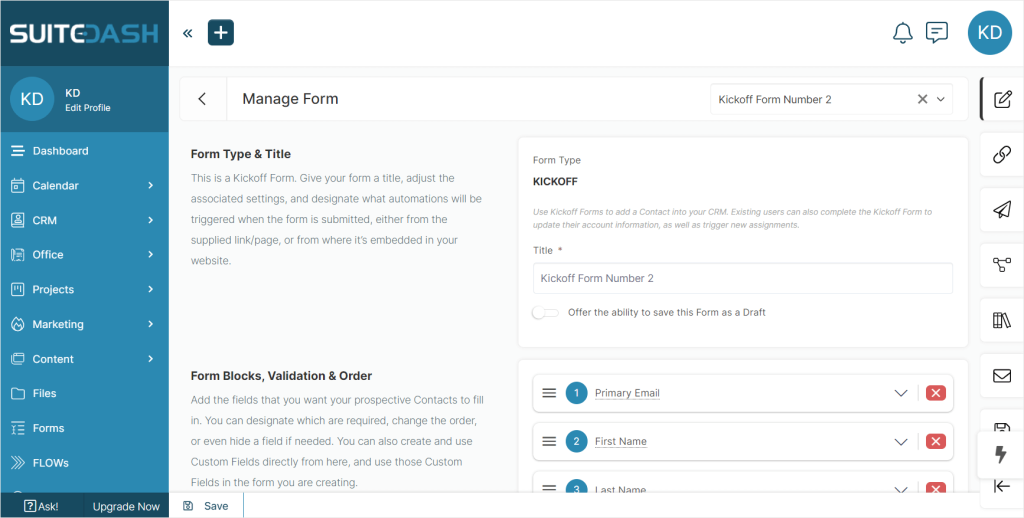
The Kickoff Form comes with various customizations and automations. Besides the required fields you’d expect from such a form — name, last name, primary email, company name, etc. — you can also use Custom Fields to gather any other information that you need.
Moreover, you can use a Choice Block to create different paths depending on the user’s choices. In practice, it means that your client will see a dropdown menu with several options to choose from. Picking one will trigger preconfigured actions.
For example, depending on the choices, the client can be saved in different roles or have different people assigned to them.
You can also choose whether you want to immediately send the Portal Access Invitation or if you’d rather do that yourself after approving the form. Or, you can embed another field called Appointments, where your clients will be able to book a meeting with you.
Client Experience
Portal Pages
To keep your clients informed at all times and give them a sense of control over their own projects, you can create Portal Pages just for them. And not only for them — you can create them for other users just as well (for example, for your team members or for yourself), or for whole groups of them (like Circles).
Sky’s the limit, or rather, your creativity and imagination.
The Portal can be built in two ways, either with the help of Article Style Editor (perfect for article-style kind of informative content where text dominates) or Content Block Editor (suited for more varied content based on pre-built layouts).
No matter the editor, you can fill out your Portal Page with all kinds of resources, from helpful articles to files and URLs, anything your users might find useful.
Clients can also leave comments for more effective communication.
Going by the official SuiteDash guide, the thought behind Portal Pages is to support your clients in the Sales Funnel and lead them through it. For example, you can make a Starting page with all the necessary basic info. Once your client fills out the form there, they can be moved to a new page based on their answers. This way, you can ensure they always have access to the right information and resources.
Dashboards
On top of that, you can create personalized Dashboards for different roles of your Staff (for example Admin, Manager, Team Member — they’re all customizable) or for individual users. A Dashboard, in other words, is an interface that can show whatever you need: Projects, Tasks, Calendar, Recent Activity, News Feed, and more.
Compared to Portal Pages, Dashboards are much more interactive and are best for the most engaged clients, who want to keep a closer eye on all the current ongoings or even collaborate with you.
Just how much they see and what they can access is entirely up to you. You can design the customer experience however you want, but this means you already need to have at least a solid idea of how you want to shape it. You need well-thought-out processes to lead your clients toward success without any mistakes or flounders.
Communication
If your clients want to get in touch with you to discuss anything they want, they can do so through SuiteDash, without bothering with emails, live chats, or calls (which is especially crucial for international business relationships).
All they have to do is to log in to the platform, navigate to Projects, choose the one they want to discuss, and then find the Client Talk tab. There, they can exchange messages with the team. The clients will be notified on the platform if anyone answers, and they can also choose to receive email notifications in settings.
Unfortunately, from a UX & UI perspective, the Client Talk tab isn’t the most efficient way of having discussions. First of all, the tab is hidden deep in the platform — someone needs to notify the client explicitly that this feature exists in the first place.
Secondly, the space for messages is tiny. You only get a third of the interface for the messages, the font is tiny, and once the conversation thread grows, you get a giant list of messages that are difficult to parse through.
That’s why, in the end, your clients might decide to write you a quick email, anyway.
In a similar vein, your team can also make use of their own space for discussions, the Team Talk tab. Somehow, we have an inkling it doesn’t beat Slack or any other instant messaging communication.
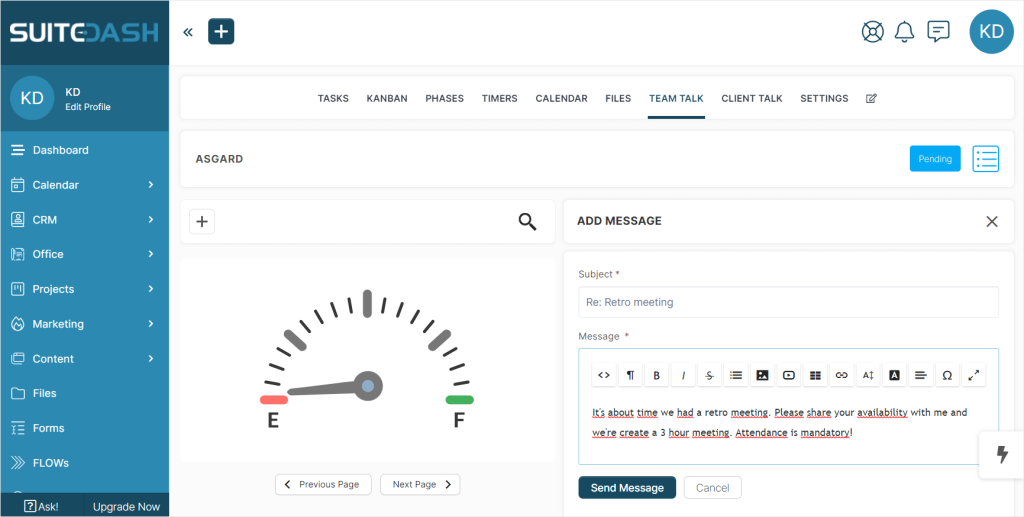
Work Requests
For those clients who might be working with you on bigger projects or on a subscription-based model, you might need a space for clients to make their requests, trusting that someone from your staff will take care of it.
To access Work Requests, you need to go to Projects → Work Requests. This feature is not as hidden as the previous one, thankfully, but there’s also nothing making it stand out.
There, your client can describe their needs, pick a deadline, attach any files, and choose from the list the Items they want as part of the service.
Items are something that you should be able to do, but we must admit, at first, it left us confused. There’s no proper guide or an explanation of what the Items are in the first place or where you can create them.
Thankfully, with the help of SuiteDash’s help center, we’ve managed to figure that out. Turns out that Items are created in Settings, which is very unintuitive — after all, you’d think that Settings are more about changing your notifications or account details.
In Settings → Projects, you can find the Work Request Items section and add what you need. There are four fields: Name, Description, Price, and Assign Circle(s), so that you can restrict visibility. Because that’s not a lot to go on, you can actually come up with many ways of using this feature to your advantage.
Once you’ve created your Items, you can manage their visibility and delete them. Meanwhile, your clients can enjoy how quickly they can make their requests, although the fact that they’re restricted by Items is a bummer.
Appointments
If sending Work Requests doesn’t cut it and your business is all about calls, meetings, and consultations, then you can allow your clients to make appointments.
Unfortunately, your clients need to be logged in to make appointments. Once they’re on the platform, they can head over to Calendar and book a slot.
For the not logged-in clients, you can send them a link to a Form that has the appointment field or guide them toward the page where you’ve embedded it, as we’ve explained in the “Onboarding New Contacts” section.
Another option is to simply share the direct link to your Appointment page.
From your side, you can set up your default availability for each day of the week. Then, you choose how long each appointment is, as well as padding, to avoid back-to-back meetings. There are also starting time intervals as well as prep-time, which sets the earliest available booking slot, so that you’re not immediately bombarded by calls. Last but not least, you get the future availability — how far into the future your clients can book you. After all, we wouldn’t want to have booked appointments in two years’ time.
Moreover, you can also be in charge of the availability of your entire Staff. If you’re scared that it might complicate matters and lead to double bookings, rest assured that SuiteDash comes with a built-in conflict checking system to save you from that ugly fate.
And of course, there’s the option to synchronize your SuiteDash calendar with the Google one. Unfortunately, it’s a one-way street, meaning that your saved events on SuiteDash will appear on the Google Calendar, but not the other way around. Which means that you’re not out of the woods when it comes to conflicts.
Business Side
Selling Productized Services
SuiteDash makes it possible to sell productized services, meaning services that have a fixed scope and price, popularized by such marketplaces as Fiverr or Upwork. Unfortunately, to discover that this option exists in the first place and then to set it up requires a bit of an investigation, which wouldn’t have been possible without Kevin, an AI live chat pretending to be a dog.
After turning the platform upside down, we’ve managed to find the “Products” tab under the Learning Management Section, of all places. But once you try to add a new Product, you’re asked whether you want it to be a Course or a Bundle of Courses.
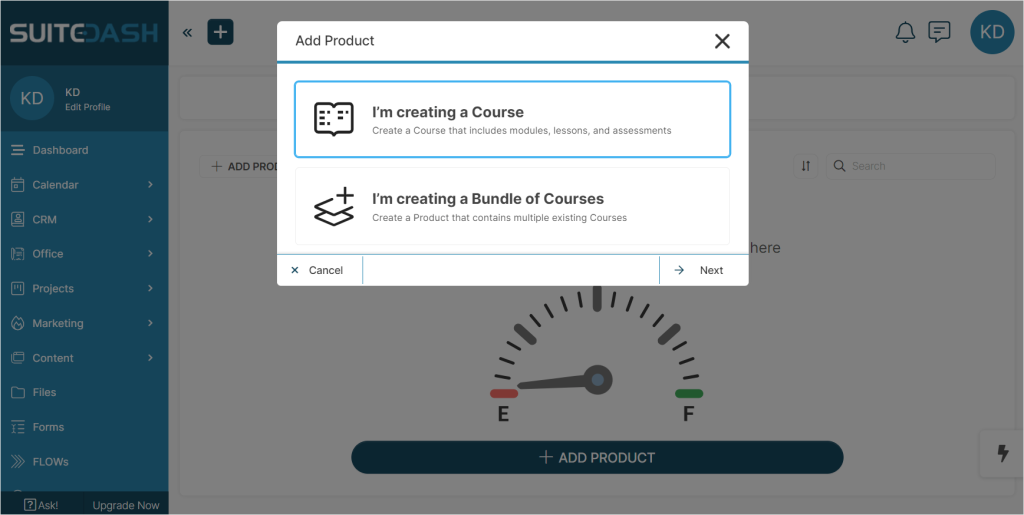
Confusion ensues. We want to sell services — not to create a course.
Thankfully, Kevin came to the rescue, explaining:
“(…) while the terminology may be a bit misleading, with a little creativity, you can use the ‘Bundles’ feature to sell your other products and services in SuiteDash.”
Another misleading thing is the fact that the Learning Management System is only accessible for people on the highest subscription tier, but apparently, if you’re on the lower tiers, the “Products” tab should still be working, but not the “Courses” tab. But since the bundles are dependent on the courses, we have no idea how that works in practice beyond the trial version.
The conclusion is, SuiteDash isn’t built around selling productized services, but there are workarounds that can make it work. It won’t be a perfect solution, but it’s something.
Selling Custom Services
If SuiteDash is not good for selling productized services, does it mean it can be used for selling custom services?
…yes, but not exactly.
SuiteDash is first and foremost a business operations management system, as confirmed by our resident expert, Kevin the AI Dog. It means that it’s built for client and team management, as well as to keep a close eye on all of the internal processes. But it’s not meant to be your selling point where you do the actual business with clients. For that reason alone, all the features necessary for making deals are hidden deeper in the platform.
If you still want to handle the selling part of your business through SuiteDash, you can do so via Projects. There, on behalf of your client, you can create a project, describe the scope, deadline, and most importantly — pricing.
Then, you can give your client access to the page and allow them to look over the project. If they’re happy with it, you can issue an invoice, which can be done from the “Office” part of the software. There, you can also create estimations & proposals to spice the customer experience up.
After issuing an invoice, your client can make a payment through a payment gateway of their choice: Stripe, Braintree, PayPal, or Authorize.net.
If you’d like to watch over your finances and have some solid numbers on your sales, you can synchronize SuiteDash with Quickbooks Online. Otherwise, SuiteDash doesn’t offer any reports or deeper insights into the financial state of your business.
SuiteDash Summary: Pros & Cons
To recap, SuiteDash has the potential to bring order to all of your internal processes, but don’t count on it to actually effectively sell your services or products or watch over your profits and expenses. To do that, you should use SuiteDash with integrations, but that’s just more expenses on top of the cost of SuiteDash itself, which we went over in-depth in the SuiteDash pricing article.
SuiteDash Pros
- Roles & Permissions. You have almost total control over the visibility of who sees what, thanks to all the roles you can customize and the permission options. Mind you, if you overcomplicate the system, you might find yourself in trouble, so it’s best to keep it as simple as possible.
- Portals & Dashboards. In a similar vein, you can create personalized spaces for all users, depending on their needs, roles, and goals. You can guide them through sales funnels or long-winded onboarding processes, or any other paths you need.
- Easy team management. SuiteDash gives you the option to watch over your clients carefully and it does the same to your Staff: you can rule over their calendars, set up their availability and hourly rates, assign tasks and projects, and more.
- Robust automations. On almost every step, you can stumble upon automation features that can help you get rid of the manual work as much as possible. It’s not easy to set up correctly, but it’s definitely worth the time.
- Many payment gateways. SuiteDash offers Stripe, Braintree, PayPal, and Authorize.net. From our experience, that’s a lot to choose from — in comparison, HoneyBook processes payments on its own.
SuiteDash Cons
- Terrible UX & UI experience. It’s pretty clear that for the SuiteDash team, design wasn’t the main priority. The features aren’t always easily accessible, and the platform itself is very unintuitive to use and often misleading. Even the “save” buttons tend to be on the left bottom corner, while everyone is used to having them on the right side. And that’s without mentioning that the software looks severely outdated.
- Steep learning curve. SuiteDash knows perfectly well how difficult it is to master; that’s why it almost drowns you with the amount of helping messages and guides on the platform itself. In the help center, you can also find an AI chatbot, which is much more helpful than the documents. On top of that, you can also make use of the SuiteDash Academy, SuiteDash Wizards, and Weekly Q&A Webinars.
- Bad communication. Although SuiteDash does offer features that make communication possible, both with clients and team members, it is cumbersome enough that most people will switch to email or instant messaging apps anyway.
- Outdated editors. There are many documents and forms that you can create with the help of SuiteDash. Unfortunately, the offered editors force you to build your own templates entirely from scratch, which makes it time-consuming. Also, the editors themselves don’t always work properly, as we have covered in our Agiled vs SuiteDash article.
- Slow. SuiteDash is a huge software a bit on the bloated side. It has many features and many tabs — as a result, it loads slowly. For impatient people, this might be annoying.
- Requires integrations. To make it truly an all-in-one solution worthy of investment, you need to integrate it with other software to make up for the lack of features, such as analytics, reporting, or finances.
- Expensive. While SuiteDash’s first subscription plan costs $19 per month, it only gives you the most basic of functionalities. To reap all the benefits described in this article, you’ll have to spend either $49 or $99 per month. If you’d like to know more about the topic, read out the SuiteDash pricing article.
Is SuiteDash for accountants a good idea to invest in? If you have everything figured out and only need a better management system for clients and teams, then that’s something you can consider. But if you’d like a simpler alternative that makes selling easy, then consider Zendo.
Zendo: Great Alternative For Accountants
Zendo is an all-in-one solution that’s focused entirely on selling custom, subscription-based, and productized services in a way that’s both straightforward and effective. It introduced a new way of doing business that revolves around healthy and transparent communication, as well as cutting out all the bells and whistles that are entirely unnecessary.
It’ll be a huge surprise to no one that nowadays, new software appears every other week. Many of them copy the already existing ones, because — as they say — there’s no point in reinventing the wheel. And while that’s true, it also means that many apps mindlessly copy the solutions that stopped working a long time ago.
One of them is the overreliance on email. The so-called all-in-one solutions do everything but offer proper communication with clients, counting on the vendors to keep discussions and negotiations outside of the platform. Which is such a shame — after all, everyone universally hates exchanging back-and-forth emails. It’s way too easy to lose important information in the long threads, especially when clients keep making new ones. And yet, few business management platforms actually help solve that issue.
Meanwhile Zendo, a fairly new software founded by Jakub Gaj and released in 2021, proposes a completely different approach to communication, which is the heart of any business. Instead of developing a poor communicator nobody remembers to check out, Zendo made chat the ultimate center of operations. Everything of importance is right there, so that you don’t have to jump around different tabs.
But let’s start at the beginning of the customer journey — the Service Catalog.
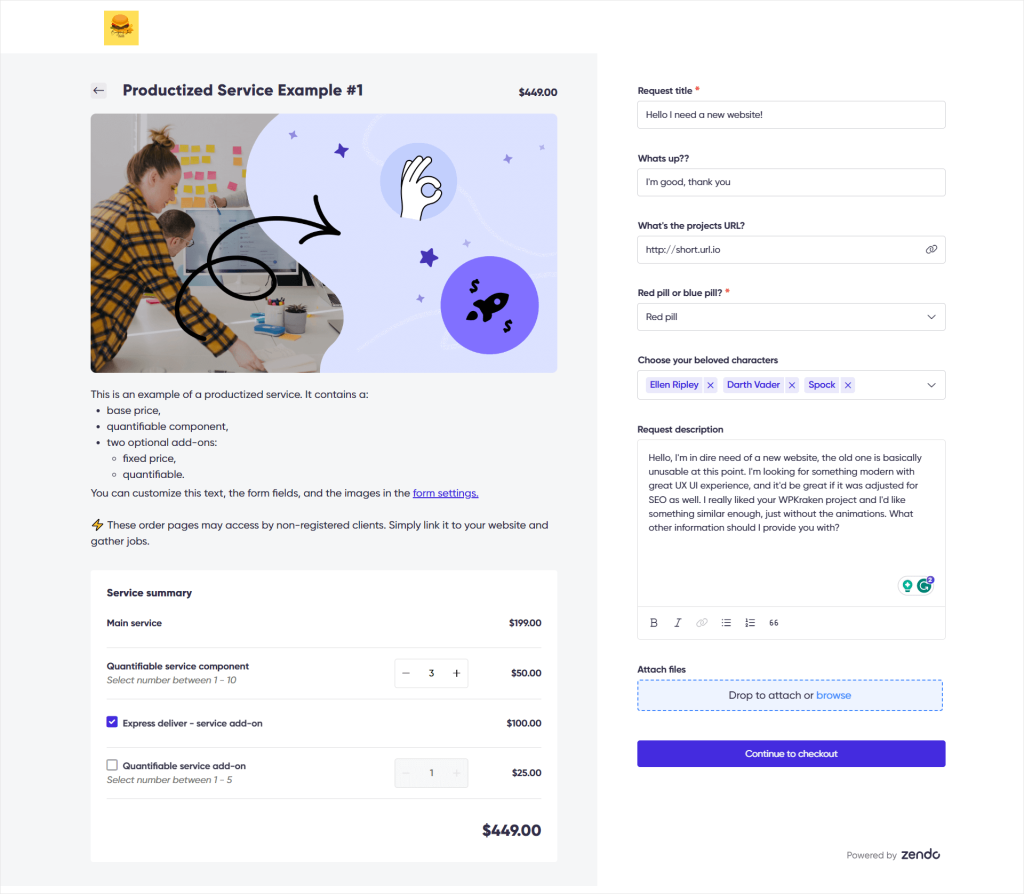
Service Catalog is a space designed for your offers to shine. First, at the Zendo platform, you create your services: free, custom, productized, subscription-based, you name it. You can further customize them with the help of Items, Addons, and Quantities, so that your clients can tailor the service to themselves. For example, you can offer rush delivery for extra money, or allow clients to choose just how many files they want to get. This way, you can take advantage of the upselling techniques as well as give your clients more control.
On top of that, you can create your own Order Form, consisting of various fields: from simple text fields to single & multiple choices as well as URLs, and more. This way, you can make sure that all the important information will be collected upfront, saving you time on needless discussions.
In the case of other popular software, you’re forced to create several different templates for Proposals, Questionnaires, and Contracts, and send them to clients, essentially drowning them in emails. Zendo’s approach bypasses that part entirely — instead of sending documents to clients, the clients themselves fill everything out upfront.
Once your client submits their request, it will land in your Zendo platform, ready to be handled by your team. Each new request creates a new conversation thread which is enriched by additional functionalities besides just exchanging messages: you can send quotes, ask for their approval, and issue invoices, while your customers will be able to finalize payments without leaving the chat.
Of course, we all know that during conversations, it’s easy to lose messages. Thankfully, Zendo thought way ahead of that — all the exchanged documents and files will be easily accessible on the right-side panel, so that you’ll never lose a thing.
And if you’d like to quickly have words with your team, you don’t have to switch to Slack or another messaging app. You can fire off private notes, which are internal messages invisible to clients. As we have already said, Zendo truly does its best to become the all-in-one solution to handle each and every part of your business.
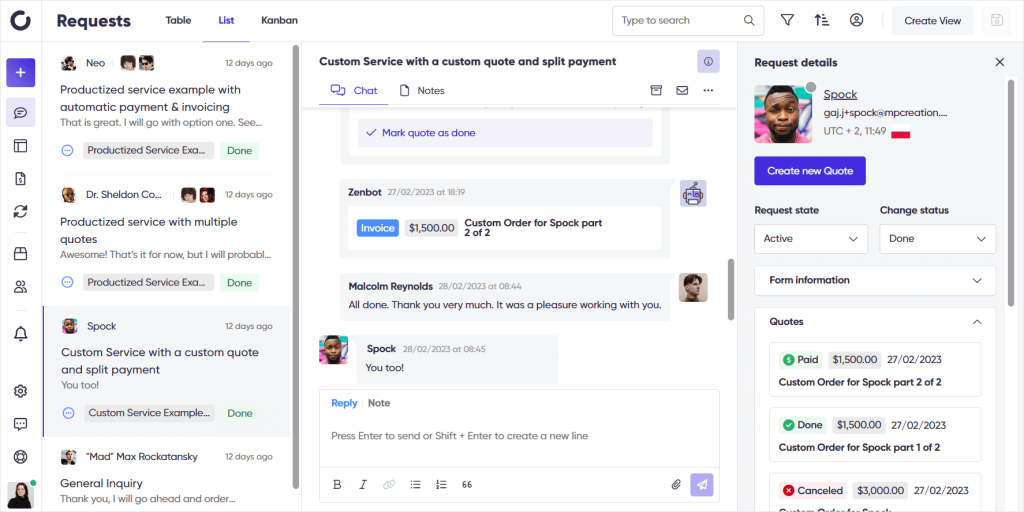
The best news though is Zendo’s pricing. It has three pricing tiers:
- Starter. A free forever plan for you and another user, where you gain access to most of the features. As a treat, you get renewable premium tokens to try out the premium features, such as automations,
- Growth. For $19 per user a month, you get access to everything Zendo has to offer,
- Enterprise. For those in need of custom features, they can choose the last subscription plan, where they can count on the Zendo team to personalize their experience. This plan requires individual estimation, which is dependent on the scope of the project.
If you’re an accountant looking for quick solutions packed in a modern design, Zendo might be what you’re looking for. Its new and fresh view on doing business will not only save you time, but money as well, while delighting your clients with a smooth sailing experience.
Interested? Sign up for Zendo’s free forever plan at once — no credit card required!

A free online training. Delivered daily to your inbox to grow your productized agency.
What Is SuiteDash?
SuiteDash is a huge business software that helps teams collaborate and optimize their interactions with clients. It’s particularly well known for its steep learning curve, which stems from the big number of available features. It comes with a Client Portal, robust automation possibilities, and subscription management.
SuiteDash For Accountants: Is It Good Enough?
SuiteDash is a business management software that focuses entirely on creating and controlling internal processes. It doesn’t help you productize your services or sell them on a subscription basis, although there are many workarounds that can make it possible. If all you need is to keep your team and contacts under a close watch, SuiteDash might be something you should seriously consider.
Are There Any Good Software For Accountants?
Unfortunately, when it comes to project & business management software, most of the tools are either universal enough to suit all kinds of companies or are tailored towards creatives, like photographers or designers. But with little creativity and imagination, you can make any software suit your needs — although that might require going on some compromises as well.
What Is Zendo?
Zendo is an all-in-one solutions with a Client Portal that helps small and medium businesses to streamline their processes and sell productized, custom, and subscription-based services quickly. Zendo doesn’t only ensure that you as a vendor will have a blast, but also elevates the customer side of experience, giving them an easy way to keep track of their requests and to keep in touch with the team.
Is Zendo Good For Accountants?
If you, as an accountant, want to productize your services or sell them on a subcription basis, then you should give Zendo a try. It will help you create products with addons that will catch your clients’ interests on the modern and clean Service Catalog. Best of all, Zendo comes with a free forever plan, where you can take your sweet time testing all the features available on the platform.











